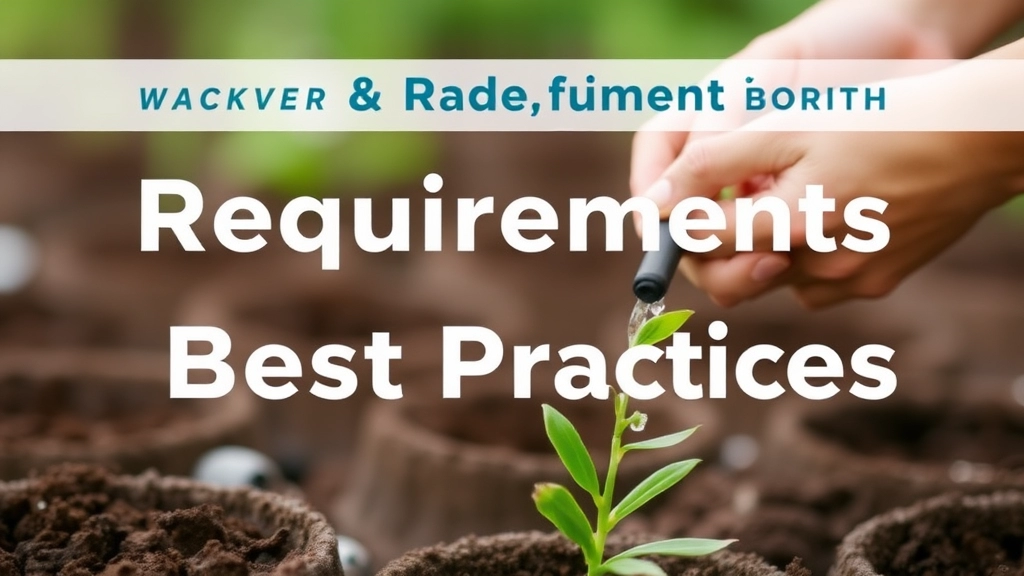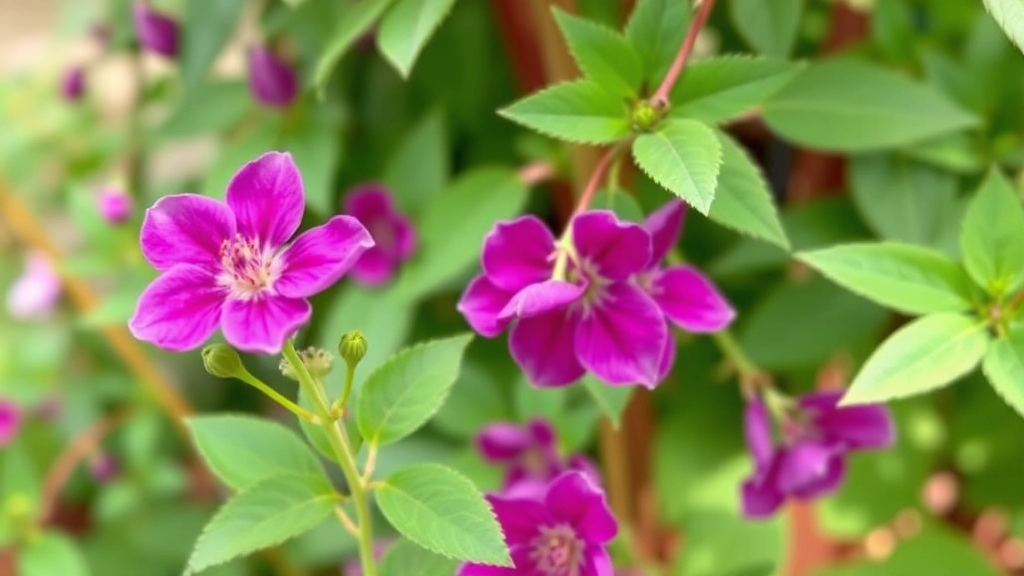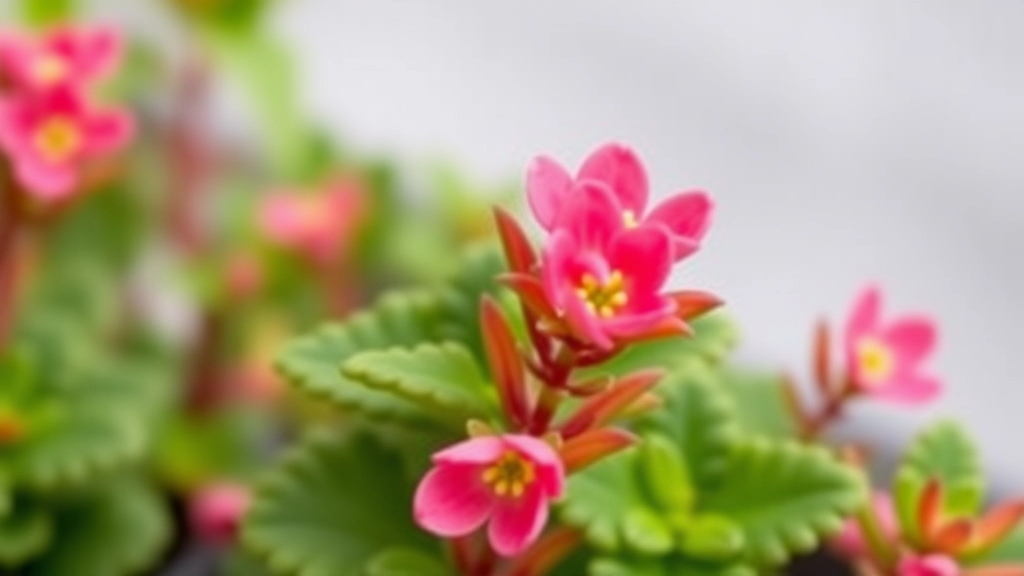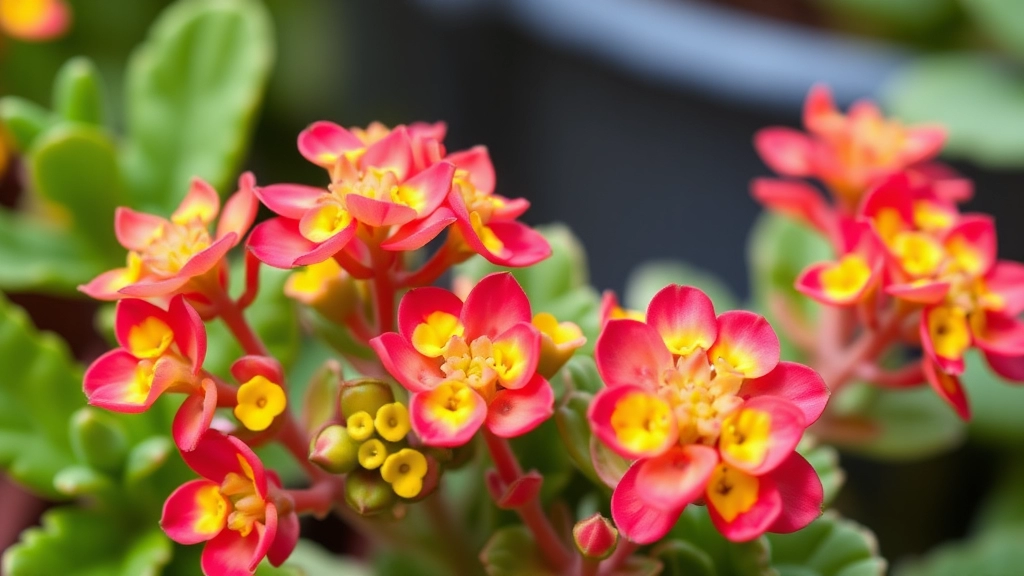Flowering Kalanchoe Care
Flowering Kalanchoe care is essential for keeping these vibrant succulents healthy and blooming. From ensuring they get the right amount of sunlight to perfecting your watering routine, there are several key factors to consider. Let’s dive into the best practices for nurturing your flowering Kalanchoe, making sure it thrives and continues to brighten your space with its beautiful blooms.
Ideal Growing Conditions
Understanding the ideal growing conditions is the first step. Flowering Kalanchoes thrive in well-draining soil and require moderate watering—too much can lead to root rot. They love bright, indirect sunlight and need a bit of fertilisation during the growing season to maintain their vibrant flowers.
Care Tips
- Pruning and Deadheading: Crucial for continuous blooms.
- Pest Management: Knowing how to handle common pests will keep your plant healthy.
By following these care tips, you can enjoy a flourishing Kalanchoe all year round.
Ideal Growing Conditions for Flowering Kalanchoe
Are you struggling to get your flowering Kalanchoe to thrive? You’re not alone. Many plant enthusiasts face challenges in creating the perfect environment for these vibrant succulents.
To ensure your Kalanchoe flourishes, it’s essential to understand its ideal growing conditions. Here are the key factors to consider:
1. Light Requirements
- Bright Indirect Light: Kalanchoe loves bright, indirect sunlight. A south or west-facing window is perfect.
- Avoid Direct Sun: Too much direct sunlight can scorch the leaves, leading to unsightly brown patches.
2. Temperature
- Warm Environment: Kalanchoe prefers temperatures between 20°C to 25°C (68°F to 77°F) during the day.
- Cool Nights: Nights should be cooler, ideally around 15°C (59°F) to encourage blooming.
3. Humidity
- Moderate Humidity: These plants thrive in moderate humidity levels. If your home is overly dry, consider misting occasionally.
- Avoid Mugginess: Excess moisture can lead to root rot, so ensure good air circulation.
4. Air Circulation
- Well-Ventilated Areas: Good airflow is essential to prevent fungal diseases. Avoid placing your Kalanchoe in a stuffy corner.
For more detailed care tips, check out our Complete Care Guide for Kalanchoe Blossfeldiana. If your Kalanchoe is not flowering despite your best efforts, you might find our article on Why Your Kalanchoe is Not Flowering helpful.
Watering Requirements and Best Practices

So, you’re wondering how often to water your flowering Kalanchoe, right? It’s a common concern for many plant lovers.
Understanding Water Needs
Kalanchoe is a succulent, which means it stores water in its leaves. This makes it a bit more forgiving when it comes to watering. Here’s the lowdown:
- Frequency: Water your Kalanchoe every 2-3 weeks during the growing season (spring and summer).
- Signs of Thirst: Look for wrinkled leaves or a dry soil surface as indicators that it’s time for a drink.
- Overwatering Alert: Yellowing leaves or a mushy stem? That’s a sign you might be giving it too much water.
Best Practices for Watering
- Check the Soil: Always stick your finger about an inch into the soil. If it feels dry, it’s time to water.
- Water Deeply: When you do water, give it a good soak until water drains out of the bottom of the pot. This encourages healthy root growth.
- Use Room Temperature Water: Cold water can shock the plant. Room temperature is best!
- Avoid Watering the Leaves: Focus on the soil to prevent rot.
- Adjust for Seasons: In winter, cut back on watering as the plant goes dormant. Once a month should suffice.
Sunlight and Temperature Needs
Are you struggling to get your flowering Kalanchoe to thrive? One of the most critical factors in ensuring its success lies in providing the right sunlight and temperature conditions.
Sunlight Requirements
Kalanchoe plants flourish in bright, indirect sunlight. Here are some key points to consider:
- Ideal Light Exposure: Aim for at least 6 hours of bright light daily. A south or west-facing window is often perfect.
- Avoid Direct Sunlight: While they love light, direct sunlight can scorch the leaves. If you notice browning or wilting, consider moving your plant a few feet back from the window.
- Supplemental Lighting: In lower light conditions, you might want to use grow lights to ensure your Kalanchoe gets the brightness it craves.
Temperature Needs
Temperature plays a vital role in the overall health of your Kalanchoe. Here’s what you need to keep in mind:
Best Soil Types for Healthy Growth

When it comes to ensuring your flowering Kalanchoe thrives, the right soil is crucial. Many plant enthusiasts often wonder, “What kind of soil do I need for my Kalanchoe?” Selecting the best soil not only promotes healthy growth but also enhances blooming potential.
Key Soil Characteristics
To create the ideal environment for your Kalanchoe, consider the following soil attributes:
- Well-Draining: Kalanchoe is susceptible to root rot, so it’s essential to use a soil mix that allows excess water to escape. Look for potting mixes labelled as “cactus” or “succulent” blends.
- Sandy Texture: A sandy or gritty texture helps improve drainage. You can mix standard potting soil with sand or perlite to achieve this.
- pH Level: Kalanchoe prefers slightly acidic to neutral soil, ideally between pH 6.0 and 7.0. Testing your soil can ensure it falls within this range.
Recommended Soil Mixes
Here are a few options for creating the best soil mix for your Kalanchoe:
- Commercial Cactus Mix: This is readily available and formulated specifically for plants like Kalanchoe.
- DIY Mix: Combine equal parts of potting soil, coarse sand, and perlite. This mix provides both nutrients and excellent drainage.
- Organic Additives: Adding materials like coconut coir can help retain moisture without compromising drainage.
Potting Considerations
When potting your Kalanchoe, ensure that the container has drainage holes. This will help prevent water from pooling at the bottom, which can lead to root issues.
In summary, the best soil for your flowering Kalanchoe is one that is well-draining, sandy, and slightly acidic. By carefully selecting the right soil mix, you set the stage for vibrant blooms and healthy growth.
Fertilization Tips for Vibrant Blooms
When it comes to ensuring your flowering Kalanchoe thrives, fertilization plays a crucial role. Many plant enthusiasts often wonder how to achieve those vibrant blooms that make Kalanchoe so desirable.
Understanding Fertilization Needs
Kalanchoe plants benefit from regular feeding, especially during their active growth phase. Here are some key tips to keep in mind:
- Type of Fertiliser: Use a balanced, water-soluble fertiliser, ideally with an NPK ratio of 15-30-15. This promotes both foliage and flower development.
- Frequency: Fertilise every 4-6 weeks during the growing season (spring and summer). Reduce feeding during the dormant months (autumn and winter).
- Dilution: Always dilute the fertiliser to half the recommended strength. This prevents root burn and ensures your Kalanchoe absorbs nutrients effectively.
- Application Method: Apply fertiliser to moist soil to prevent shock. Water the plant thoroughly before adding the fertiliser solution.
Signs of Nutrient Deficiency
Keep an eye out for signs that your Kalanchoe may need more nutrients:
- Pale Leaves: A lack of colour can indicate insufficient nutrients.
- Poor Bloom Production: If your plant isn’t flowering as expected, it may need a nutrient boost.
- Stunted Growth: Slow growth can signal that your Kalanchoe isn’t receiving enough fertiliser.
By following these tips, you can ensure your Kalanchoe remains healthy and produces those stunning blooms you desire. For more detailed care tips, check out our guide on flowering Kalanchoe care. Additionally, if you’re curious about why your plant may not be flowering, our article on causes and fixes for non-flowering Kalanchoe can provide valuable insights.
Pruning and Deadheading for Continuous Bloom

Ever looked at your Kalanchoe and thought, “Why aren’t there more flowers?” You’re not alone! Pruning and deadheading are key to keeping your flowering Kalanchoe vibrant and blooming.
Why Prune?
Pruning helps:
- Encourage New Growth: Snipping away old stems can stimulate fresh blooms.
- Maintain Shape: A tidy plant looks better and is healthier.
- Prevent Disease: Removing dead or damaged leaves reduces the risk of pests and diseases.
When to Prune?
- After Blooming: Once your Kalanchoe has finished its flowering cycle, it’s the perfect time to prune.
- Regular Maintenance: Keep an eye on the growth throughout the year.
How to Prune:
- Use Clean, Sharp Tools: This prevents infection.
- Cut Above a Leaf Node: This encourages new growth from that point.
- Remove Dead or Yellowing Leaves: This keeps the plant healthy.
Deadheading for Continuous Blooms
Deadheading is simply removing spent flowers. Here’s why it matters:
- Promotes New Blooms: By taking off old flowers, you signal the plant to produce more.
- Keeps the Plant Looking Fresh: No one likes a plant with wilted flowers!
How to Deadhead:
- Pinch Off the Flower: Use your fingers or scissors to snip off the spent blooms.
- Do It Regularly: Check your plant weekly during the blooming season.
By integrating these simple pruning and deadheading techniques, you’ll not only keep your Kalanchoe looking its best but also encourage a more robust blooming cycle.
Have you ever wondered why your Kalanchoe isn’t blooming as it should? You’re not alone. Many plant enthusiasts face this dilemma, but the good news is that encouraging reblooming in Kalanchoe is achievable with a few simple steps.
Kalanchoe typically blooms once a year, but with the right care, you can coax it into flowering multiple times.
Key Strategies for Encouraging Reblooming:
– **Light Exposure**: Ensure your Kalanchoe receives bright, indirect sunlight for at least six hours daily. This is crucial for triggering new blooms.
– **Watering Schedule**: Allow the top inch of soil to dry out before watering. Overwatering can discourage blooming.
– **Temperature Control**: Maintain a consistent temperature between 18°C to 24°C. Sudden temperature fluctuations can stress the plant, hindering its ability to bloom.
– **Fertilisation**: Use a balanced fertiliser every four to six weeks during the growing season. A high phosphorus fertiliser can also promote blooming.
– **Pruning**: After the initial blooms fade, trim away dead flowers and stems. This encourages the plant to focus energy on new growth and flowers.
– **Dormancy Period**: After blooming, allow the plant to rest. Reduce watering and stop fertilising for about six weeks. This rest is essential for future blooms.
– **Light Manipulation**: If you want to encourage blooming during the off-season, consider providing 14 hours of darkness followed by 10 hours of light for several weeks.
By following these steps, you can significantly increase the chances of your Kalanchoe blooming again. For more detailed care tips, you might find our [guide on outdoor Kalanchoe care](https://planthq.org/outdoor-kalanchoe-care-expert-tips-and-best-practices/) helpful. Additionally, understanding the [flowering cycle of Kalanchoe](https://planthq.org/kalanchoe-flowering-season-in-india-care-tips-best-time/) can provide further insights into how to manage your plant’s blooming periods effectively.
Common Pests and How to Prevent Them

So, you’ve got your Kalanchoe thriving, but what about those pesky pests that might want to crash the party?
Common Pests to Watch For:
- Aphids: Tiny green or black bugs that suck the life out of your plant.
- Mealybugs: Cotton-like clusters that hide in the leaf joints.
- Spider Mites: These little guys are barely visible but can cause big damage, leaving webbing on your leaves.
- Whiteflies: Small white insects that flutter around when disturbed.
Prevention Tips:
- Keep It Clean: Regularly wipe down leaves to remove dust and any lurking pests.
- Quarantine New Plants: Always isolate new additions for a couple of weeks before introducing them to your collection.
- Natural Predators: Ladybugs and lacewings are like the superheroes of the garden. They feast on aphids and mealybugs.
- Neem Oil Spray: A natural pesticide that’s effective against many pests. Just mix with water and spray on affected areas.
- Healthy Plants: A robust Kalanchoe is less likely to attract pests. Ensure you’re following the best care practices.
If you notice any signs of pests, act fast! A small issue can quickly turn into a big problem.
Propagation Methods: Cuttings, Offsets, and Seeds
As we explore the care of flowering Kalanchoe, understanding propagation methods is essential for expanding your collection or sharing with friends.
Cuttings
One of the easiest and most popular ways to propagate Kalanchoe is through cuttings. Here’s how to do it:
- Select a Healthy Stem: Look for a healthy, non-flowering stem.
- Make the Cut: Use a clean, sharp knife or scissors to cut a 4-6 inch section.
- Let It Callus: Allow the cutting to dry for a few hours or overnight. This helps prevent rot.
- Planting: Place the cutting in well-draining soil and water lightly.
- Care: Keep the soil slightly moist and provide indirect sunlight until roots develop.
Offsets
Kalanchoe often produces offsets, or “pups,” that can be easily separated and replanted.
- Identify Offsets: Look for small plants growing at the base of the parent plant.
- Remove Carefully: Gently twist or cut the offset away from the main plant.
- Replant: Place the offset in its own pot with suitable soil.
- Water: Water sparingly until established.
Seeds
While less common, Kalanchoe can also be propagated from seeds.
- Seed Collection: If your plant flowers, collect seeds from the dried flower heads.
- Sow Seeds: Scatter seeds on the surface of well-draining soil.
- Moisture: Lightly mist the soil to keep it moist but not soggy.
- Light: Place the container in a warm, bright location but avoid direct sunlight.
By employing these propagation methodsâcuttings, offsets, and seedsâyou can easily expand your Kalanchoe collection. For more detailed instructions, check out our guide on how to propagate Kalanchoe Blossfeldiana cuttings. Additionally, if you’re interested in the unique characteristics of different Kalanchoe varieties, our identification guide can be a valuable resource.
Potting and Repotting Guidelines for Flowering Kalanchoe

So, you’ve got your Kalanchoe thriving, and now you’re wondering about the best way to pot or repot it? You’re not alone! Many plant lovers face this dilemma, and it’s crucial for keeping your plant healthy and vibrant.
When to Repot
- Signs Your Kalanchoe Needs a New Home:
- Roots are poking out of the drainage holes.
- The soil dries out too quickly.
- You notice stunted growth.
Choosing the Right Pot
- Size Matters:
- Go for a pot that’s just one size larger.
- Too big, and the soil will stay wet too long.
- Drainage is Key:
- Make sure your pot has drainage holes.
- Kalanchoe hates soggy roots!
Potting Process
- Prepare Your Materials:
- Fresh potting mix (preferably a cactus or succulent blend).
- A clean pot with drainage holes.
- Remove Your Kalanchoe:
- Gently ease it out of its current pot.
- Be careful with the roots; you don’t want to damage them!
- Inspect the Roots:
- Trim any dead or rotten roots.
- This helps prevent disease.
- Fill the New Pot:
- Add a layer of soil to the bottom.
- Position your Kalanchoe in the centre and fill around it with more soil.
- Water Sparingly:
- After potting, give it a light watering.
- Let the soil dry out before the next watering.
Repotting Frequency
- Every 1-2 Years:
- This keeps your Kalanchoe in fresh soil and allows for growth.
- Don’t skip it; your plant will thank you!
Troubleshooting Growth Issues: Leggy Stems and Sparse Flowers
Have you noticed that your Kalanchoe is looking a bit leggy or struggling to produce vibrant blooms? You’re not alone. Many plant enthusiasts face these common growth issues, and addressing them can help restore your plant’s health and beauty.
Identifying Leggy Stems
Leggy stems occur when your Kalanchoe stretches towards light, resulting in elongated, weak growth. This can be frustrating, especially when you expect a compact, bushy plant.
Causes of Leggy Growth:
- Insufficient Light: Kalanchoe thrives in bright, indirect sunlight. If it’s not getting enough light, it will stretch.
- Overwatering: Too much water can weaken stems, making them more prone to stretching.
- Lack of Pruning: Regular pruning encourages bushier growth.
Solutions for Leggy Stems:
- Increase Light Exposure: Move your plant closer to a window where it can receive ample indirect sunlight.
- Adjust Watering Habits: Ensure the soil dries out between waterings to promote stronger growth.
- Prune Regularly: Trim back leggy stems to encourage fuller growth.
Sparse Flowers
Sparse flowering can be equally disappointing. If your Kalanchoe isn’t blooming as expected, it may be due to several factors.
As we dive into seasonal care and dormancy adjustments, you might be wondering how to keep your flowering Kalanchoe thriving throughout the year.
### Understanding Dormancy
Kalanchoes, like many plants, have a dormancy period, typically in the winter months. This is when they slow down growth and conserve energy.
#### What to Expect During Dormancy:
– **Reduced Growth**: You might notice fewer new leaves or blooms.
– **Lower Water Needs**: The plant requires less water; overwatering can lead to root rot.
– **Temperature**: They prefer cooler temperatures during this time, ideally between 10-15°C.
### Seasonal Care Tips
To keep your Kalanchoe happy through the seasons, here are some straightforward tips:
#### Winter Care:
– **Light**: Ensure they still get plenty of indirect sunlight.
– **Watering**: Cut back on watering; let the soil dry out completely between waterings.
– **Temperature**: Keep them in a room where the temperature doesn’t drop too low.
#### Spring Awakening:
– **Reintroduce Fertilizer**: Start feeding with a balanced fertiliser to kickstart growth.
– **Increase Watering**: Gradually increase watering as the plant begins to wake up.
– **Repot if Needed**: Check if it’s time to [repot](https://planthq.org/how-to-plant-kalanchoe-in-a-pot-stepbystep-guide/); a larger pot can promote healthier growth.
#### Summer Growth:
– **Keep Hydrated**: Ensure consistent watering but avoid soggy soil.
– **Sunlight**: Place them in a spot where they can soak up more sunlight.
– **Pest Watch**: Keep an eye out for pests; they love the warm weather.
#### Autumn Prep:
– **Reduce Watering**: As temperatures drop, scale back on watering again.
– **Pruning**: Trim any dead or leggy growth to prepare for dormancy.
– **Store Fertiliser**: Stop fertilising as the plant prepares to rest.
### Why Adjustments Matter
Making these seasonal adjustments not only helps your Kalanchoe survive but thrive. By understanding its needs throughout the year, you’re setting the stage for vibrant blooms and healthy growth. For more detailed care tips, check out our [ultimate guide to Kalanchoe care](https://planthq.org/how-to-care-for-kalanchoe-succulent-ultimate-guide/).
FAQs on Flowering Kalanchoe Care
How often should I water my flowering Kalanchoe?
Water your Kalanchoe every 2-3 weeks during the growing season (spring and summer). In winter, cut back on watering to about once a month.
What are the signs that my Kalanchoe needs water?
Look for wrinkled leaves or a dry soil surface as indicators that it’s time to water.
How can I prevent overwatering my Kalanchoe?
Signs of overwatering include yellowing leaves or a mushy stem. Always check the soil by sticking your finger about an inch into it. If it feels dry, it’s time to water.
What type of soil is best for Kalanchoe?
Kalanchoe thrives in well-draining, sandy soil. Look for potting mixes labeled as “cactus” or “succulent” blends, or create a DIY mix with equal parts potting soil, coarse sand, and perlite.
How do I prune my Kalanchoe for continuous blooms?
Prune your Kalanchoe after its flowering cycle by snipping away old stems and removing dead or yellowing leaves. This encourages new growth and maintains the plant’s shape.
What is deadheading, and why is it important?
Deadheading is the process of removing spent flowers. It promotes new blooms and keeps the plant looking fresh. Regularly check your plant during the blooming season and pinch off the spent blooms.
What are common pests that affect Kalanchoe, and how can I prevent them?
Common pests include aphids, mealybugs, spider mites, and whiteflies. Prevent them by keeping the plant clean, quarantining new plants, and using natural predators like ladybugs. Neem oil spray is also effective against many pests.
When should I repot my Kalanchoe?
Repot your Kalanchoe when you notice roots poking out of the drainage holes, the soil dries out too quickly, or you see stunted growth. Generally, repotting every 1-2 years is recommended.
What kind of pot should I use for my Kalanchoe?
Choose a pot that’s just one size larger than the current one and ensure it has drainage holes. Kalanchoe prefers well-draining conditions and dislikes soggy roots.
How should I water my Kalanchoe after repotting?
After repotting, give your Kalanchoe a light watering and let the soil dry out before the next watering. This helps the plant adjust to its new environment.
References
-
The Spruce – How to Grow and Care for Kalanchoe Indoors
-
Gardening Know How – Kalanchoe Plant Care: Learn How To Grow Kalanchoe Plants
-
The Old Farmer’s Almanac – Kalanchoe
